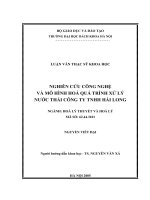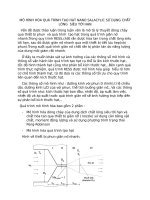mô hình của quá trình chưng cất
Bạn đang xem bản rút gọn của tài liệu. Xem và tải ngay bản đầy đủ của tài liệu tại đây (227.72 KB, 15 trang )
Mô Hình Hóa
quá trình Chưng cất
Modeling the unit:
We are interested in developing the
unsteady state model for the unit using the
flowing assumptions:
Notation:
100% tray efficiency
Well mixed condenser drum and re-boiler.
Liquids are well mixed in each tray.
Negligible vapor holdups.
liquid-vapor thermal equilibrium
Li, Vi
Liquid and vapor molar rates
Hi, hi
Vapor and liquid specific
enthalpies
xi, yi
Liquid and vapor molar
fractions
Mi
Liquid holdup
q
Liquid fraction of the feed
z
Molar fractions of the feed
F
Feed molar rate
Vn, yn
R, xd
Vn, yn
stage n
(a)
(b)
Qc
R, xd
D, xd
Vi, yi
Li+1, xi+1
Ln, xn
Vn-1, yn-1
Vf , yf
Lf+1, xf+1
stage i
stage f
(c)
(d)
Vi-1, yi-1
Li, xi
L2, x2
V1, y1
Lf, xf
Vf-1, yf-1
VB, yB
Qr
stage 1
(f)
(e)
L1, x1
VB, yB
L1, x1
B, xB
Stage n+1 (Condenser),
Total mass balance:
dM D
Vn ( R D )
dt
(2.161)
Component balance:
d ( M D xD, j )
Vn yn , j ( R D ) x D , j
dt
j 1, nc 1
(2.162)
Energy balance:
d ( M D hD )
Vn H n ( R D )hD Qc
dt
Note that R = Ln+1 and the subscript D denotes n+1
(2.163)
Stage n,
Total Mass balance:
dM n
Vn 1 Vn R Ln
dt
(2.164)
Component balance:
d (M n xn, j )
dt
Vn 1 y n 1, j Vn y n , j Rx D , j Ln x n , j
j 1, nc 1
(2.165)
Energy balance:
d ( M n hn )
Vn 1H n 1 Vn H n RhD Ln hn
dt
(2.166)
Stage i,
Total Mass balance:
dM i
Vi 1 Vi Li 1 Li
dt
(2.167)
Component balance:
d ( M i xi , j )
Vi 1 yi 1, j Vi yi , j Li 1 xi 1, j Li xi , j
dt
j 1, nc 1
(2.168)
Energy balance:
d ( M i hi )
Vi 1H i 1 Vi H i Li 1hi 1 Li hi
dt
(2.169)
Stage f (Feed stage),
Total Mass balance:
dM f
dt
V f 1 (V f (1 q) F ) L f 1 ( L f qF )
(2.170)
Component balance:
d (M f x f , j )
V f 1 y f 1, j (V f y f , j (1 q ) Fz j ) L f 1 x f 1, j ( L f x f , j qFz j )
dt
j 1, nc 1
(2.171)
Energy balance:
d (M f h f )
dt
V f 1 H f 1 (V f H f (1 q) FH f ) L f 1h f 1 ( L f h f qFh f )
(2.172)
Stage 1,
Total Mass balance:
dM 1
VB V1 L2 L1
dt
(2.173)
Component balance:
d ( M 1 x1, j )
VB y B , j V1 y1, j L2 x2, j L1 x1, j
dt
j 1, nc 1
(2.174)
Energy balance:
d ( M 1h1 )
VB H B V1H 1 L2 h2 L1h1
dt
(2.175)
Stage 0 (Re-boiler),
Total Mass balance:
dM B
VB L1 B
dt
(2.176)
Component balance:
d ( M B xB , j )
VB y B , j L1 x1, j BxB , j
dt
j 1, nc 1
(2.177)
Energy balance:
d ( M B hB )
VB H B L1h1 BhB Qr
dt
Note that L0 = B and B denotes the subscript 0
(2.178)
Additional given relations:
Phase equilibrium: yj = f (xj, T,P)
Liquid holdup: Mi = f (Li)
Enthalpies: Hi = f (Ti, yi,j), hi = f (Ti, xi,j)
Vapor rates: Vi = f (P)
Degrees of freedom analysis
Variables
Mi
n
MB, MD
2
Li
n
B,R,D
3
xi,j
n(nc − 1)
xB,j,xD,j
2(nc − 1)
yi,j
n(nc − 1)
yB,j
nc − 1
hi
n
hB, hD
2
Hi
n
HB
1
Vi
n
VB
1
Ti
n
TD, TB
2
Total
11+6n+2n(nc−1)+3(nc−1)
Equations:
Total Mass
n+2
Energy
n+2
Component
(n + 2)(nc − 1)
Equilibrium
n(nc − 1)
Liquid holdup
n
Enthalpies
2n+2
Vapor rate
n
hB = h1
1
yB = x B
(nc − 1)
Total
Constants: P, F, Z
7+6n+2n(nc-1)+3(nc-1)
Therefore; the degree of freedom is 4
To well define the model for solution we include four relations
imported from inclusion of four feedback control loops as follows:
Use B, and D to control the liquid level in the condenser drum and
in the re-boiler.
Use VB and R to control the end compositions i.e., xB, xD
Simplified Model
One can further simplify the foregoing model by the
following assumptions:
a) Equi-molar flow rates, i.e. whenever one mole of liquid vaporizes
a tantamount of vapor condenses. This occur when the molar heat
of vaporization of all components are about the same.
This assumption leads to further idealization that implies constant
temperature over the entire column, thus neglecting the energy
balance.
In addition, the vapor rate through the column is constant and equal
to:
VB = V1 = V2 =… = Vn
(2.179)
(b) Constant relative volatility, thus a simpler formula for the phase
equilibrium can be used:
yj = aj xj/(1+(aj − 1) xj)
(2.180)
Degrees of Freedom:
Variables:
Equations:
Mi, MB, MD
n+2
Total Mass
n+2
Li, B,R,D
n+3
Component
(n + 2)(nc − 1)
xi,xB,xD
(n + 2)(nc − 1)
Equilibrium
n(nc − 1)
yj, yB
(n + 1)(nc − 1)
Liquid holdup
n
yB = xB
1
V
1
Total
2 + 2n + (2n + 3)(nc − 1)
Total
2+2n+(2n+3)(nc-1)
It is obvious that the degrees of freedom is still 4.









